Journal of Ergonomics
Open Access
ISSN: 2165-7556
ISSN: 2165-7556
Research Article - (2023)Volume 13, Issue 3
Studies have revealed that physical and mental demands, psychosocial factors, and individual factors can contribute to the development of WMSDs. Yet, much is still unknown regarding the effects of individual characteristics on WMSDs susceptibility. Previous studies discovered people assumed more awkward body postures to perform an activity when the perception of mental workload is higher. This research study explored if individual characteristics such as age, sex, personality, and anxiety help explain changes or differences in the perception of mental workload and body postures assume when performing activities. The study provided evidence that these individual characteristics have a modifying role on perceived mental workload and body postures. The results suggest that perceived mental workload is influenced to a higher extent by individual characteristics such as anxiety, sex, and personality traits. On the other hand, body postures seem to be influenced by different individual factors depending on the nature of the activity.
Individual factors; Mental workload; Body posture
Oakman and Macdonald [8] addressed organizational, technical, and individual factors in an attempt to identify the key predictors of WMSDs risk. Age, sex, psychosocial hazards, and physical demands contribute significantly to the level of discomfort, explaining approximately one-quarter of the variance in the model. They highlight the importance of incorporating physical, psychosocial, and individual factors to have a more comprehensive and holistic multi-dimensional approach when researching WMSDs risk prediction or assessment. A growing body of research has shown a complex relationship between postural control and mental workload that depends among other factors of age, expertise, type of cognitive task, and cognitive processing required [28-33]. This association between body behavior and mental workload also appears to depend on other individual characteristics such as sex and personality [25,34]. Mental workload is a multidimensional construct involving the characteristics of the task, the operator, and the environment where the task is performed. It incorporates psychosocial factors,
Organizational work factors and individual differences that are still an unsolved puzzle regarding their impact on mental workload assessment [16,17,35]. It is believed that interactions between those factors impact performance and health status [14,18]. Studies have demonstrated that changes in postural or physical behavior can be a result of tasks that are perceived as mentally stressful; a condition that can be exacerbated by psychosocial factors such as time pressure, intensity, and duration of the task demands [34,36,37]. Perceived mental workload has negative effects on body postures. People assumed worse body postures to perform an activity when the perception of mental workload is higher [38,39]. However, little is known about the potential influence of individual characteristics on the perception of mental workload and body postures. Individual factors are those related to the characteristics of the worker such as sex, age, social class, culture, education status, personality traits, attitudes towards life, job satisfaction, depression, anxiety, among others [40-42]. The present study explored if individual characteristics such as age, sex, personality trait, and anxiety trait rating can help to explain variability in the perception of mental workload and body postures arising from the introduction of changes in the environment and working conditions (distractions, interruptions, noise, time available) in which the subject must perform the tasks.
It was hypothesized that individual factors such as age, sex, personality, and anxiety level can help to explain changes in the perception of mental workload and the body postures assumed to perform the activities. The objective of the study was to investigate if individual factors mediate or exacerbate the influence of psychosocial work factors on the perception of mental workload and body postures responses.
Participants
Field test: Thirty-two volunteers from a university community (31% staff and 69% students), mostly young adults 25.53 ± 7.96 years old, with a distribution of 53% females and 47% males participated in the study. To recruit participants for this experiment, we sent a promotional flyer to students and staff inside Montana State University using the university mail list. Participants belonged to different university departments and units. Participants were free of lower and upper extremity surgeries, had no lower and upper extremity injuries within three months of study participation, and had not diagnosed concussions within a year of study participation. Study participation involved one lab visit lasting between 1.5-2 hours.
Experimental design
The Approval from the University’s Institutional Review Board was obtained before recruitment and experimentation. Informed consent was obtained from all participants. Participants performed two physical tasks at four levels of mental workload (baseline, time constraint, alarm, and interruption). The physical activities were divided into a whole-body task performed standing and an upper-extremity task performed seated (Figures 1a and 1b).
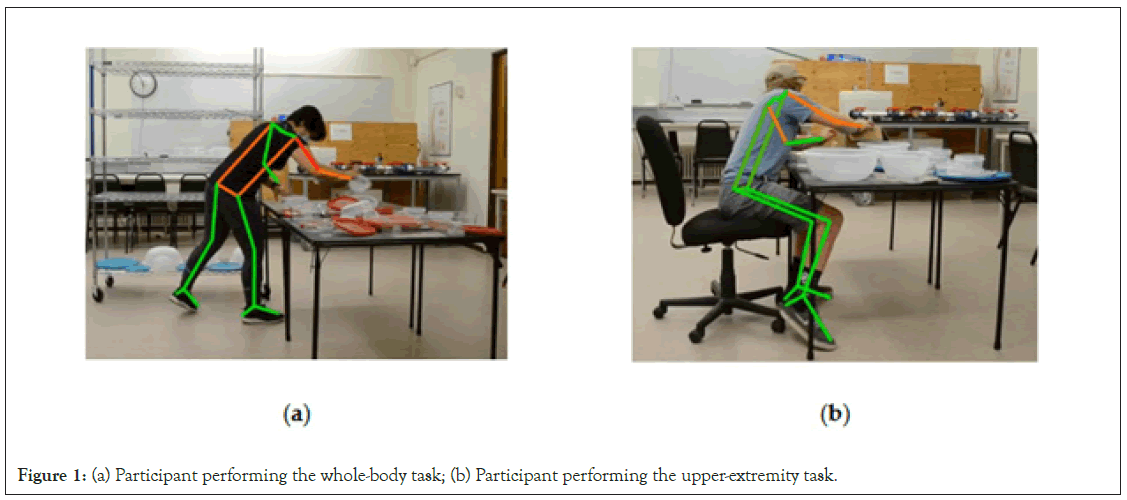
Figure 1: (a) Participant performing the whole-body task; (b) Participant performing the upper-extremity task.
The experimental tasks emulated activities performed in the sterile processing department (SPD) of a hospital. Specifically, the whole-body task emulated loading a rack with surgical trays to wash them, an activity performed in the decontamination area in the SPD while the upper extremity/seating condition emulated the assembly of trays performed at the sterilization area in the SPD. A repeated measure within-subjects experimental design was used by having participants perform both physical tasks under the different workload conditions. These various conditions were designed to manipulate the perception of mental workload, which was manipulated by including a time constraint to complete the activity, auditory stimuli (an alarm), and interruptions. The baseline condition consisted of the participant performing the physical tasks in the absence of any mental workload stressors, for a total of 8 combinations of treatments. Participants were not instructed to use any specific lifting technique or adopt specific postures to complete the tasks.
Each subject went through all eight treatment conditions. Apart from the baseline condition being completed first, conditions were randomly presented to the participants to avoid any order effects. At the end of each condition, a rest period of 2-3 minutes was provided to minimize cumulative mental and physical fatigue. During the rest period, participants filled out the subjective mental workload assessment tools. For more details about the experiment see [33]. Independent variables consisted of individual characteristics including age, sex, anxiety STAI trait rating, and personality traits. Personality traits were classified into Extraverts or Introverts, Sensors or Intuitors, Thinkers or Feelers, and Judgers or Perceivers [43,44].
Myers-Briggs Type Indicator (MBTI) was used to characterize participants’ personality traits [44]. MBTI is one of the most widely used instruments to assess personality, applied in more than 700 research studies [25,45,46]. It consists of four pairs of opposite preferences, called dichotomies: 1) Extraversion (E) or Introversion (I); 2) Sensing (S) or Intuition (N); 3) Thinking (T) or Feeling (F) and; 4) Judging (J) or Perceiving (P). The MBTI instrument combines the four preferences denoted by its letter producing 16 possible personality types (e.g., ENTJ, ISFP). Each of these personality types could influence people’s responses to a certain work situation or task and, under certain circumstances, can energize or stress a person [47]. The MBTI has proven to be reliable for use in various work situations, various ethnic groups, age groups, international samples across six regions, including Africa, Asia, Australia, Europe, Latin America, and the Middle East. MBTI has shown superior internal consistency and test-retest reliability compared to other personality assessments [46,48,49]. Spielberger’s State-Trait Anxiety Inventory (STAI) was used to measure anxiety in the participants [43]. The STAI is a self-report designed to measure and differentiate anxiety as a trait and as a state. It was decided to use only the trait anxiety part since it refers to feelings of tension, apprehension, and it seems like a stable personality trait. People with high trait anxiety tend to see more situations as dangerous as those with lower trait scores [43]. The STAI-Trait consists of a 20-item questionnaire ranging from 20 to 80 points that describes how people generally feel. The STAI has been used in more than 816 published studies [50]. Reliability, validity, and sensitivity of the STAI have been reported by [50-53]. Dependent variables consisted of perception of mental workload and body postures. Perception of mental workload was assessed by the NASA Task Load Index (NASA- TLX) [54], using equal weights for the total load score (raw NASA- TLX, or RTLX) [55-57]. The NASA-TLX is a multidimensional questionnaire designed to obtain a subjective measure of mental workload on six dimensions: mental demand, physical demand, temporal demand, performance, effort, and frustration. NASA- TLX is considered the most robust tool available for reporting mental workload perceptions and overall workload perceptions [58,59]. The NASA-TLX questionnaire was administrated after each treatment condition.
Body postures were measured using the Rapid Entire Body Assessment (REBA) method [60] for the standing activity, and the Rapid Upper Limb Assessment (RULA) method [61] for the sitting activity. REBA is a postural analysis tool that provides a quick and easy measure to assess a variety of working postures for risk of WMSDs [60,62] and has been proven to be suitable for whole-body evaluations. RULA is a valid and reliable tool used to evaluate the risk of musculoskeletal disorders associated with specific tasks within a job and to determine exposure to possible risk factors such as posture, repetitive motion, and force. It is used to evaluate task demand on the trunk, neck, and upper extremities [61]. RULA and REBA were designed for easy use and have the advantages of being inexpensive and requiring only minor equipment [63-66].
Experimental procedure
The study was conducted in the Human Factor Laboratory at Montana State University (MSU) during the summer and fall of 2021. Upon arrival, participants signed a consent form and filled out two questionnaires, the Myers-Briggs Type Indicator (MBTI) and the Spielberger State-Trait Anxiety Inventory (STAI-Trait). Other individual characteristics of the participants were collected such as age and sex assigned at birth. Participants complete two physical activities, the whole-body task and the upper-extremity task that emulate activities performed at the sterile processing department (SPD) in a hospital, under four different conditions. In general, participants’ perceptions of mental workload and body postures were assessed and objectively compared under four different conditions of two physical activities (whole-body and upper-extremity task) in which the physical demands were kept constant and the workstation design was the same. Manipulations of psychosocial factors included a time constraint to complete the tasks, an alarm, and an interruption. Psychosocial factors were introduced to manipulate and control the perception of mental workload to determine the effects on body postures assumed by the participants to perform the experimental activities [33]. The effects of individual factors on perceived mental workload and body posture were then explored. Since the experiments were conducted during the unset of the COVID-19 pandemic, a risk of exposure to the novel coronavirus, COVID-19 was mitigated by following strict sanitation protocols that included, but were not limited to, deep cleaning and disinfection of all lab equipment before and after use, frequent hand washing, and the wearing of face coverings at all times. Social distancing of 6 feet between participant and researchers was adhered to whenever possible, with the exception being during the moments in which participants had some questions about the tasks they were about to perform. Before participants entered the lab, they were asked to complete a COVID-19 screening per MSU guidance. Research procedures complied with ongoing MSU COVID-19 guidelines.
Analyses
Descriptive statistics were used to analyze the demographics and general characteristics of the sample. Repeated measures analysis of variance (ANOVA) was performed for all dependent variables. Analyses were done including each of the individual characteristics, one at a time, condition (baseline, time constraint, alarm, and interruption), and the interaction effect between the individual factor and condition. The goal was to evaluate individual characteristics’ main and interaction effects on perceived mental workload and body postures. After these analyses, a forward selection stepwise general linear model (Alpha to enter 0.25) was created for each of the response variables (NASA-TLX, REBA, and RULA scores), including condition as a main effect and also all the individual characteristics (age, sex, anxiety rating, and personality traits). This was done to directly compare the relative ability of these individual factors to explain variance in the response variables, following a multi-causal framework and laying out the contributions of the different factors as proposed by Cole DC et.al [67]. Factors that reached statistical significance was analyzed further using post-hoc comparisons via Tukey multiple pairwise comparisons. All statistical analyses were evaluated at a significant level of α=0.05. Multiple comparison corrections were not used in this exploratory study.
Table 1 summarizes information about the thirty-two participants’ sex, age, anxiety trait rating, and personality type. It can be seen from Table 1 that the average age, anxiety trait, and MBTI dichotomies distribution was similar for males and females (Table 1).
| Participant | Sex | Age (Yrs) | Anxiety Trait | MBTI Personality | Extraverts/Introverts | Sensors/Intuitors | Thinkers/Feelers | Judgers/Perceivers |
|---|---|---|---|---|---|---|---|---|
| 1 | F | 23 | 53 | ENFJ | E | N | F | J |
| 2 | F | 27 | 41 | ISTJ | I | S | T | J |
| 3 | M | 27 | 36 | INTJ | I | N | T | J |
| 4 | F | 22 | 51 | ESFP | E | S | F | P |
| 5 | M | 31 | 39 | INFJ | I | N | F | J |
| 6 | F | 25 | 43 | ISTJ | I | S | T | J |
| 7 | F | 26 | 26 | ENFJ | E | N | F | J |
| 8 | F | 58 | 23 | ENFJ | E | N | F | J |
| 9 | F | 29 | 37 | ENFJ | E | N | F | J |
| 10 | M | 19 | 32 | ESFJ | E | S | F | J |
| 11 | M | 30 | 47 | ENFP | E | N | F | P |
| 12 | F | 21 | 39 | ENFJ | E | N | F | J |
| 13 | M | 24 | 54 | ENTJ | E | N | T | J |
| 14 | F | 20 | 38 | INFJ | I | N | F | J |
| 15 | F | 21 | 32 | ISFJ | I | S | F | J |
| 16 | F | 21 | 57 | ISFJ | I | N | F | P |
| 17 | F | 27 | 51 | ISFJ | I | S | F | J |
| 18 | M | 21 | 51 | ENTJ | E | N | T | J |
| 19 | F | 22 | 32 | ESTJ | E | S | F | J |
| 20 | F | 21 | 31 | ENFJ | E | N | F | J |
| 21 | M | 21 | 64 | ENFP | E | N | F | P |
| 22 | F | 21 | 63 | ISTJ | I | S | T | J |
| 23 | M | 20 | 45 | ENFJ | E | N | F | J |
| 24 | M | 18 | 28 | ESTJ | E | S | T | J |
| 25 | M | 19 | 37 | ENFP | E | N | F | P |
| 26 | M | 34 | 38 | ENFJ | E | N | F | J |
| 27 | F | 31 | 56 | INFP | I | N | F | P |
| 28 | M | 21 | 38 | INTP | I | N | T | P |
| 29 | M | 41 | 31 | ESFJ | E | S | F | J |
| 30 | M | 19 | 63 | ESFJ | E | S | F | J |
| 31 | F | 24 | 34 | ENFJ | E | N | F | J |
| 32 | M | 33 | 34 | ENFP | E | N | F | P |
| Male | 15 | 25.2 | 42.47 | E=12 | S=4 | T=5 | J=10 | |
| (7.05) | (11.22) | I=3 | N=11 | F=10 | P=5 | |||
| Female | 17 | 25.82 | 41.59 | E=9 | S=7 | T=3 | J=14 | |
| (8.9) | (11.72) | I=8 | N=10 | F=14 | P=3 | |||
| All | 32 | 25.53 | 42 | E=21 | S=11 | T=8 | J=24 | |
| (7.96) | (11.31) | I=11 | N=21 | F=24 | P=8 |
Note: Average values with standard deviations in parentheses. MBTI=Myers-Briggs Type Indicator: introversion (I)/extroversion (E), sensing (S)/intuition (N), thinking (T)/feeling (F), judging (J)/perceiving (P).
Table 1: Participants individual characteristics: Sex, age, anxiety rating, and personality traits.
In general, participants’ perceptions of mental workload and body postures were assessed and objectively compared under four different mental workload conditions of two physical activities (whole-body task and upper-extremity task) in which the physical demands were kept constant and the workstation design was the same. Psychosocial factors (time, alarm, interruption) generated higher perceptions of mental workload when compared against the baseline condition. Higher mental workload perceptions were associated with worse body postures when compared with the baseline condition. These results demonstrated that people assumed more awkward body postures to perform an activity under higher levels of perceived mental workload (see more in the results section on [33]). Regarding the influence of individual factors, perceived mental workload for the whole-body activity varied markedly when different individuals were subjected to the various conditions (Figure 2). Some participants demonstrated substantial increases in the perception of mental workload (NASA-TLX scores), whereas others exhibited smaller differences. This behavior was also observed in the NASA-TLX scores for the upper-extremity task. Likewise, body postures assumed to perform the activities, evaluated using the Rapid Entire Body Assessment (REBA) and Rapid Upper Limb Assessment (RULA), exhibited similar behavior when different individuals were exposed to the mental workload conditions. The following results are focused on presenting the individual characteristics (sex, age, anxiety, and personality) that seems to explain such differences in body postures (RULA and REBA indices) and perceived mental workload (NASA- TLX scores) (Figure 2).
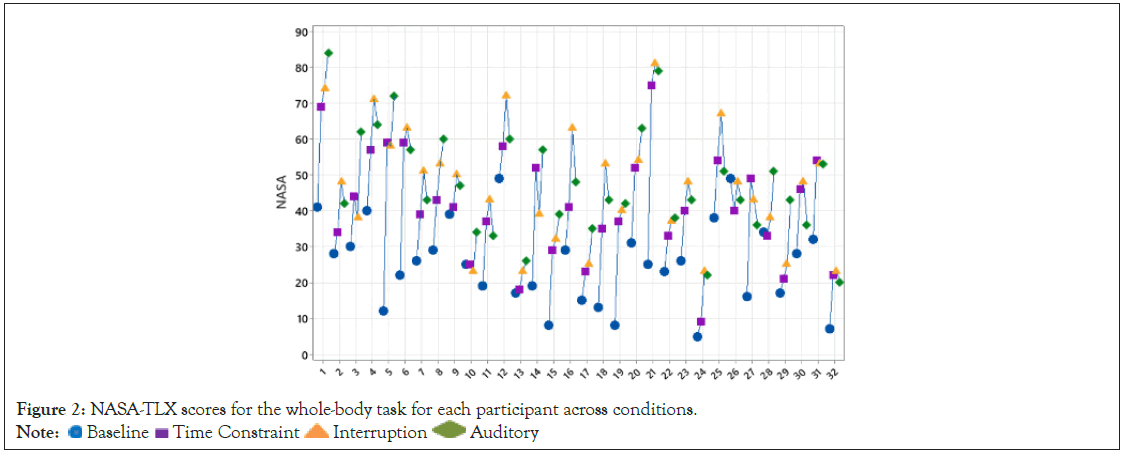
Figure 2: NASA-TLX scores for the whole-body task for each participant across conditions.
Note:  Auditory
Auditory
Table 2 summarizes the ANOVA analyses performed including one of the individual factors, at a time, condition, and the interaction effect between condition and the individual characteristics. Each row in the table shows the p-values for the individual characteristics in each of the models. The condition row presents the higher p-values obtained after all models were evaluated. No interaction effects were observed between condition and any of the individual characteristics (sex, age, anxiety trait rating, and personality traits) for any of the response variables (NASA-TLX, RULA, REBA scores) (Table 2).
| Standing Task | Sitting Task | |||
|---|---|---|---|---|
| Effect | NASA-TLX | REBA | NASA-TLX | RULA |
| Condition | < 0.008* | <0.001* | <0.012* | <0.001* |
| Sex | 0.008* | 0.527 | 0.994 | 0.439 |
| F>M | ||||
| Extroverts/Introverts | 0.445 | 0.822 | 0.753 | 0.011* |
| I > E | ||||
| Sensors/Intuitors | <0.001* | 0.29 | <0.001* | 0.048* |
| N>S | N>S | N>S | ||
| Thinkers/Feelers | 0.009* | 0.306 | 0.241 | 0.345 |
| F>T | ||||
| Judgers/Perceivers | 0.183 | 0.051 | 0.014* | 0.829 |
| P>J | ||||
| Anxiety | 0.038* | 0.803 | 0.208 | 0.389 |
| Age | 0.568 | 0.968 | 0.018* | 0.141 |
Note: *indicates p<0.050
Table 2: Statistical summary (p-values) of significant analysis of variance for NASA-TLX, REBA, and RULA scores.
Sex was a main effect for NASA-TLX scores in the whole-body activity (Table 2). When the NASA-TLX scores in the standing task were contrasted for males and females, a difference was observed for females (43 ± 16) compared with males (37 ± 17), 18.7% higher NASA-TLX scores for females. It seems that women had a higher perceived mental workload for the whole- body activity across the conditions (Figure 3). However, as seen in Table 2, sex was not significantly associated with NASA-TLX for the sitting task, REBA, and RULA scores (Figure 3).
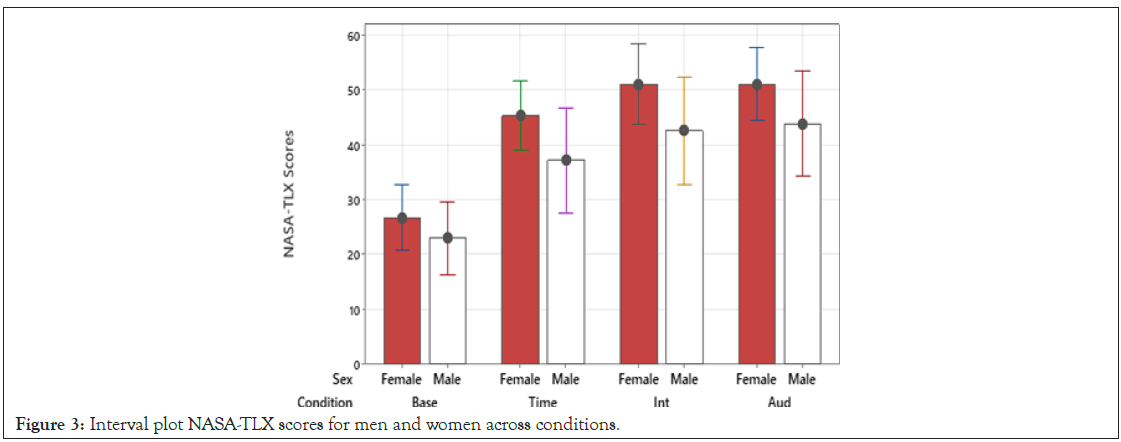
Figure 3: Interval plot NASA-TLX scores for men and women across conditions.
A significant difference in RULA scores occurred between extroverts and introverts (Table 2), with higher RULA scores for introverts (6.3 ± 0.7) than extroverts (5.9 ± 0.8) across conditions (Figure 4). No other significant differences were linked to extroverts and introverts (Figure 4).
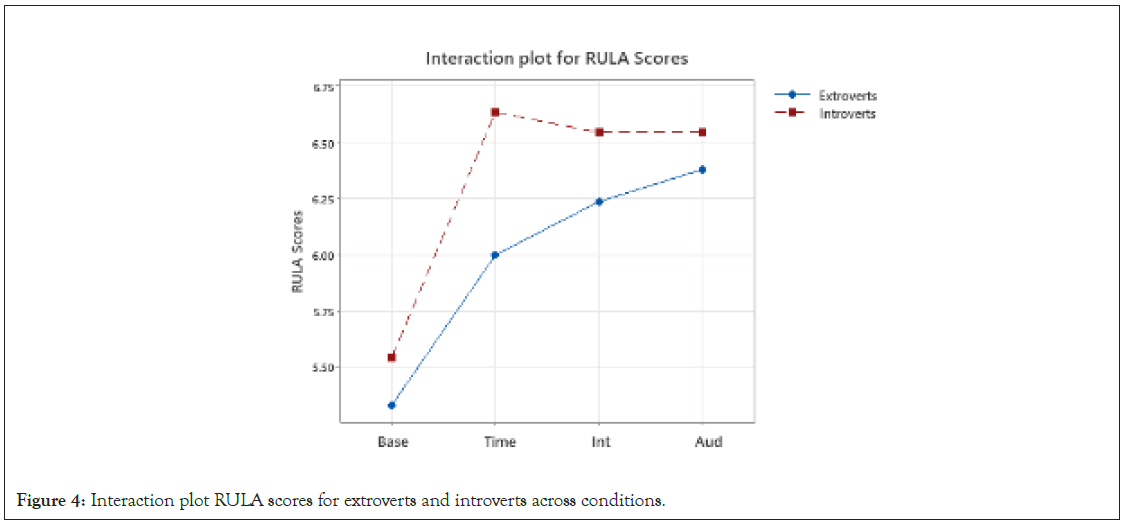
Figure 4: Interaction plot RULA scores for extroverts and introverts across conditions.
A main effect for sensors and Intuitors was observed for NASA- TLX scores in both activities (standing and sitting) and for RULA scores (Table 2). Intuitors had worse RULA scores (6.2 ± 0.8) than sensors (5.9 ± 0.8) and higher perceptions of mental workload across the conditions. NASA-TLX scores for the whole- body activity were higher for intuitors (43.83 ± 17.0) than for sensors (33.61 ± 15.6). Likewise, the perceived mental workload in the upper-extremity task was higher for intuitors (45.54 ± 15.3) than for sensors (35.70 ± 13.7) (Figure 5). No differences were observed between intuitors and sensors for REBA scores (Figure 5).
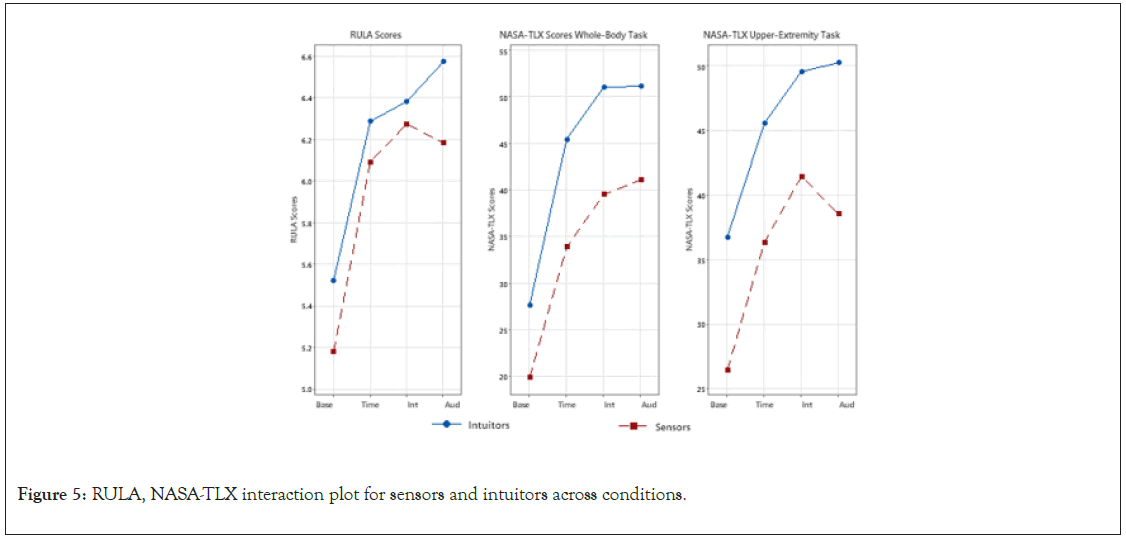
Figure 5: RULA, NASA-TLX interaction plot for sensors and intuitors across conditions.
While An effect for thinkers versus feelers was observed for NASA-TLX scores in the whole-body activity. Perception of mental workload was higher for feelers (42.3 ± 15.2) than thinkers (34.4 ±17.4) across conditions REBA, RULA, and NASA-TLX scores in the sitting task exhibited no change for thinkers versus feelers. Regarding judgers versus perceivers, a main effect was only observed for NASA-TLX scores in the upper extremity task, with a higher perception of mental workload experienced by the perceivers (47.6 ± 16.3) than the feelers (40.3 ± 14.5) across conditions (Figures 6a and 6b).

Figure 6: Interval plot NASA-TLX scores for (a) Feelers and thinkers across conditions; (b) Judgers and Perceivers across conditions.
A main effect of anxiety was observed for NASA-TLX scores for the whole-body activity (Table 2). In general, higher perceptions of mental workload were observed for participants with higher anxiety trait ratings (coefficient for anxiety=+0.241 anxiety rating) A main effect of age was observed for NASA-TLX scores in the upper-extremity task (Table 2). Perception of mental workload was higher for younger participants (coefficient for age=-0.387 years) (Figures 7 and 8).
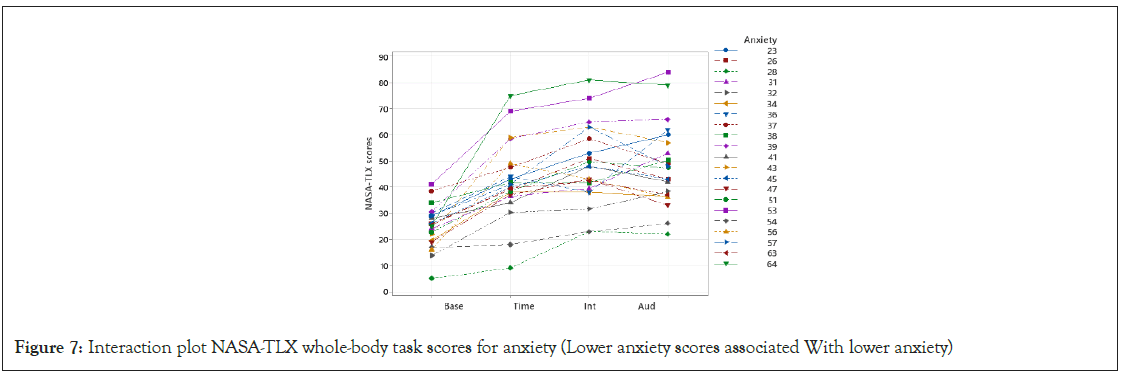
Figure 7: Interaction plot NASA-TLX whole-body task scores for anxiety (Lower anxiety scores associated With lower anxiety)
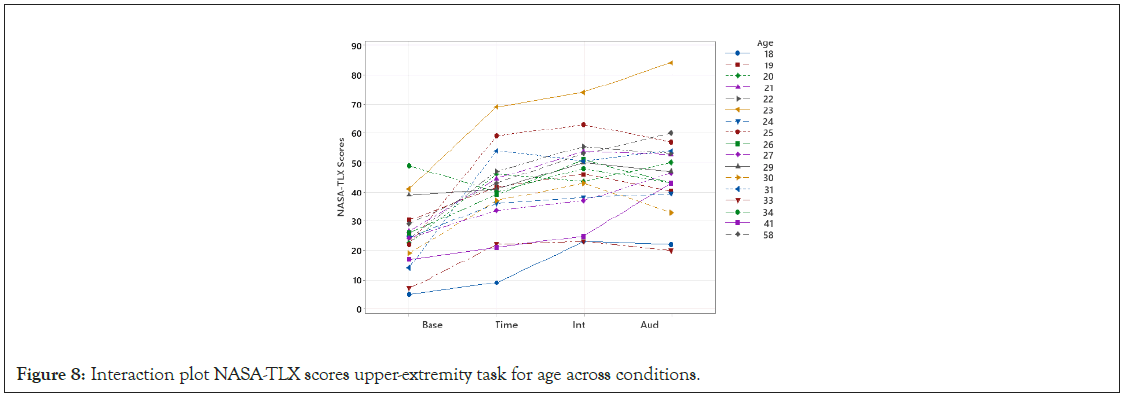
Figure 8: Interaction plot NASA-TLX scores upper-extremity task for age across conditions.
Forward selection stepwise general linear models were performed to identify the relative ability of the individual characteristics to explain the variance in the response variables. When studying the NASA-TLX scores for the whole-body task, factors of condition, sensors/intuitors, sex, and anxiety were statistically significant (in decreasing significant order), resulting in a model that explained 44.24% of the variability in the data. Personality traits such as extroverts/ introverts were not independently significant (p=0.077). Personality traits thinkers/feelers, judgers/perceivers, and individual factors such as age were not even part of the model (for more details about the model see appendix A (Table A1).
| Source | DF | Seq SS | Contribution | Adj SS | Adj MS | F-Values | P-Value |
|---|---|---|---|---|---|---|---|
| Anxiety | 1 | 923.7 | 2.46% | 1457.2 | 1457.2 | 8.85 | 0.004 |
| Condition | 3 | 10760.3 | 28.68% | 10760.3 | 3586.8 | 21.78 | 0 |
| Sex | 1 | 1604.5 | 4.28% | 2879.8 | 2879.8 | 17.48 | 0 |
| Extraverts-Introverts | 1 | 944.5 | 2.52% | 524.4 | 524.4 | 3.18 | 0.077 |
| Sensors-Intuitors | 1 | 3517 | 9.37% | 3517 | 3517 | 21.35 | 0 |
| Error | 120 | 19765.9 | 52.69% | 19765.9 | 164.7 | - | - |
| Total | 127 | 37515.9 | 100.00% | - | - | - | - |
Table A1: General linear model NASA-TLX whole-body task analysis of variance.
A model that explained 24.90% of the variability for the NASA- TLX scores in the upper- extremity task included factors (in decreasing significant order) such as condition, sensors/intuitors, and age. In this case, sex, anxiety, and the rest of the personality traits thinkers/feelers, extroverts/introverts, judgers/perceivers, were not part of the model (See appendix A (Table A2).
| Source | DF | Seq SS | Contribution | Adj SS | Adj MS | F-Values | P-Value |
|---|---|---|---|---|---|---|---|
| Age | 1 | 1176 | 3.89% | 1865 | 1865.2 | 10.43 | 0.002 |
| Condition | 3 | 3771 | 12.46% | 3771 | 1256.9 | 7.03 | 0 |
| Sensors-Intuitors | 1 | 3480 | 11.51% | 3480 | 3480.4 | 19.46 | 0 |
| Error | 122 | 21824 | 72.14% | 21824 | 178.9 | - | - |
| Total | 127 | 30251 | 100.00% | - | - | - | - |
Table A2: General linear model NASA-TLX upper-extremity task analysis of variance.
REBA scores variability exhibit an interesting behavior by being explained (R2=27.14%) by only one factor, judgers/perceivers in addition to condition. Anxiety, age, sex, and thinkers/feelers, extroverts/introverts, and sensors/intuitors were not present in this model (See appendix A (Table A3).
| Source | DF | Seq SS | Contribution | Adj SS | Adj MS | F-Values | P-Value |
|---|---|---|---|---|---|---|---|
| Condition | 3 | 78.031 | 27.17% | 78.031 | 26.01 | 15.79 | 0 |
| Judgers-Perceivers | 1 | 6.51 | 2.27% | 6.51 | 6.51 | 3.95 | 0.049 |
| Error | 123 | 202.677 | 70.57% | 202.677 | 1.648 | - | - |
| Total | 127 | 287.219 | 100.00% | - | - | - | - |
Table A3: General linear model NASA-TLX upper-extremity task analysis of variance.
The RULA model explained 31.96% of the variability in the data and considers condition, extroverts/introverts, sensors/intuitors, and thinkers/feelers (in decreasing significant order).
Factors such as sex, age, anxiety, and judgers/perceivers were not part of the model (for more details about the model see appendix A (Table A4).
| Source | DF | Seq SS | Contribution | Adj SS | Adj MS | F-Values | P-Value |
|---|---|---|---|---|---|---|---|
| Condition | 3 | 21.398 | 26.20% | 21.398 | 7.1328 | 16.3 | 0 |
| Extraverts-Introverts | 1 | 3.146 | 3.85% | 5.236 | 5.2365 | 11.97 | 0.001 |
| Sensors-Intuitors | 1 | 2.938 | 3.60% | 2.362 | 2.3619 | 5.4 | 0.022 |
| Thinkers-Feelers | 1 | 1.25 | 1.53% | 1.25 | 1.25 | 2.86 | 0.094 |
| Error | 121 | 52.947 | 64.82% | 52.947 | 0.4376 | - | - |
| Total | 127 | 81.68 | 100.00% | - | - | - | - |
Table A4: General linear model RULA scores analysis of variance.
These results show that anxiety, personality traits, and sex are the individual characteristics with higher contributions in the response variables. Perceived mental workload for the whole- body task increased by an average of 66.0% when comparing baseline against the time constraint condition. Across conditions, larger increases in perceived mental workload were observed for certain types of individuals (e.g., females (69.2%) and feelers (69.3%)). NASA-TLX scores for the upper-extremity task increased by an average of 27.7% between the baseline and time constraint conditions. Consistently across conditions, NASA-TLX scores exhibited larger increases for perceivers (43%). RULA scores increased on average by 13.1% between baseline and time constraint conditions. Larger differences were observed on certain individuals (e.g., introverts (19.7%) and intuitors (13.8%)) across conditions. Sensors/intuitors turned out to be a key factor in explaining variability in perceived mental workload and body postures. This personality trait dichotomy was the only individual characteristic present in almost all the models developed to explain the outcomes on the response variables. In general, intuitors exhibited higher NASA-TLX scores for both tasks and RULA scores.
This study sought to understand how individual characteristics such as sex, anxiety rating, age, and personality traits can explain differences in how people respond to changes in mental workload. The results showed no interaction effects between individual factors and conditions therefore individual characteristics did not influence how people responded to changes in mental workload induced by psychosocial factors. However, individual characteristics were associated with differences in perceived mental workload appears to depend on anxiety trait ratings. The NASA- TLX scores for the whole-body task were higher for participants with higher anxiety, following what has been expressed in previous studies that people who have high trait anxiety tend to perceive more situations as threatening or dangerous than people who have lower trait anxiety ratings [50,68]. This is an important discovery because anxiety is becoming a common mental health disorder [69,70] and studies have also found that females are twice more likely to reach the cut-off for high anxiety levels than men [71]. The present study demonstrates that individual factors such as anxiety could influence perceived mental workload which in turn could increase the possibility of developing WMSDs [17- 19,21]. Another interesting finding associated with this study was that personality traits might affect perceived mental workload and body postures. Different personalities traits help explain part of the variability observed in the response variables. For instance, introverts tend to internalize their thoughts and feelings and when facing new or unfamiliar situations they are very likely to mishandle the situation [72] which could explain the higher perception of mental workload observed in the participants across conditions. Intuitors, for example, have difficulty performing repetitive tasks [72], an aspect that might explain why this personality trait (S/N) was observed as a main effect factor for NASA-TLX scores in both activities and REBA scores. Although RULA scores were worse for introverts (5.9 ± 0.8) than extroverts (6.3 ± 0.7), and for intuitors (6.2 ± 0.8) than for sensors (5.9 ± 0.8), all groups are still in the medium-risk range of development of musculoskeletal disorders, indicating that further investigation and changes are required soon. RULA scores were statistically significant between the personality trait dichotomies, however, there were not clinically significant because they correspond to the same musculoskeletal risk.
These findings suggest that people with different personality traits perceived mental workload differently and assumed different body postures when performing tasks. Personality can interfere by manipulating somatic sensations and interpretation. For instance, an activity could be considered stressful to one person and might generate higher mental workload and body postures scores, while the same activity may be considered as a challenge to achieve and on the contrary would generate a feeling of joy or motivation in the person which could reduce mental workload scores and not generate changes on body postures [72,73]. Regarding the effect of sex, the results show that perceived mental workload is affected by sex. NASA-TLX scores for the whole-body activity were 18.7% higher for females compared to males. Sex was a contributing factor explaining the variability of NASA-TLX scores for the whole-body activity, indicating that this individual factor should be considered when analyzing perceptions of mental workload as has also been stated by Cole and Rivilis [67] who point out those individual factors such as sex affect personal responses to workplace exposure. Research is needed to understand the nuances of this relationship, because of the inconsistencies between the response variables. Age was a significant factor for NASA-TLX scores in the upper-extremity task. The perceived mental workload was higher in younger participants.
This behavior of age regarding significance on variance explained in each of the responses could be attributable to the fact that age is a difficult variable to de-construct. For instance, it could be a measure of cumulative exposure, decrease tolerance, greater experience, different skills, different biomechanical exposures, among other factors [74-76]. The study shows a lack of interaction effects between the individual factors (age, sex, anxiety, personality traits) and condition (baseline, time constraint, alarm, interruption). While the individual characteristics (age, sex, anxiety, and personality traits) influenced perceived mental workload and body postures, these effects do not seem to be condition specific. These results are contradictory with previous studies that have demonstrated interaction effects of individual factors with mental workload conditions [25,34]. However, the psychosocial factors included in this study to manipulate perceived mental workload are substantially different from those used in the studies mentioned before. Therefore, this is an interesting finding that provides additional insight into the role of these individual factors on perceived mental workload generated by psychosocial factors such as time, alarm, and interruptions. Collectively, the results suggest that the associations between psychosocial factors, individual characteristics, perceived mental workload, and body postures are complex. Perceived mental workload and body postures are mixed reactions to the work environment influenced by psychosocial factors such as time, alarms, and interruptions, and the person’s unique attributes. Based on the study results, it can be said that there is an association between psychosocial factors and perceived mental workload that defines and influences the body postures assumed to perform a task. In addition, perceived mental workload and body posture are associated with individual characteristics. However, more research is needed to expand our understanding of the influence of Individual factors on perceived mental workload, body postures, and the potential association with work-related musculoskeletal disorders (WMSDs).
The results presented in here should be interpreted with caution because the current study is exploratory in nature and therefore the study was not powered enough or perhaps the design of the study was not suited to evaluate the causal influence of individual factors, more research is needed to fully determine how factors such as age, sex, anxiety, and personality traits, and the interactions between these factors may influence the risk to workers who are exposed to different work environments. Future studies could be done by focusing the assessment on only two levels of mental workload and ensuring the recruitment of enough participants representative of each of the personality traits dichotomies to be able to identify specific associations between the personality traits and perception of mental workload and their influence on body postures. Similarly, studies can be performed by having enough representation of participants with high and low anxiety levels and from both sex groups (male and female) to evaluate in a more precise way the influence of anxiety ratings on the perception of mental workload and the potential effect on body postures. Comparably, much is still unknown regarding the age effect on perceived mental.
Workload and body postures. Future studies investigating aspects of this factor are necessary. Likewise, future studies could avoid some psychometric limitations about the reliability and validity of the MBTI that have raised concerns about its use by practitioners (Boyle, 1995) by using the Big Five Inventory model instead, to identify personality traits. Future studies may be better able to assess the impact of personality traits by using The Big Five Inventory (FBI) model (John, Donahue, & Kentle, 1991) of personality traits which has been shown to remain stable throughout most of one’s lifetime (Cobb-Clark & Schurer, 2012; Raad & Perugini, 2002). The findings also indicate areas for future exploration to determine the impacts of mental workload on muscle-specific tasks, with additional information from biomechanical responses considering for instance forces exerted, duration of exertions, and muscle activities to identify connections with body postures and the risk of developing WMSDs.
The results of the current study suggest that individual characteristics such as age, sex, anxiety level, and personality have a modifying role on perceived mental workload and body postures. The study provides evidence that perceived mental workload is influenced to a higher extent by individual characteristics such as anxiety, sex, and personality traits. On the other hand, body postures seem to be influenced by different individual factors depending on the nature of the activity. For the whole-body activity, body postures are influenced to a greater extent by anxiety ratings and personality traits. The body postures for the upper-extremity task are more influenced by personality traits. Out of the individual factors considered in the study, the one with higher influence in almost all the response variables is sensors/intuitors, followed by extroverts/introverts, age, and sex. Based on the results, it seems that factors related to the individual should be clearly distinguished and addressed separately since they can interfere by manipulating somatic sensations and interpretations. Collectively, these results suggest that individual factors should be considered when attempting to evaluate all the risk factors that occurred during work and their possible influence on the perception of the task and hand, postures assumed to perform a task, and their potential influence on the development of WMSDs. This research would help to improve the design of ergonomics interventions to reduce WMSDs by following a more holistic approach that calls for the consideration of the physical demands of the task but also mental demands that in turn could be affected by psychosocial factors. Continuing to incorporate and examine the influence of psychosocial and organizational work factors on perceived mental workload, body postures, and human behavior may lead to suggesting or identifying possible paths to create and/or improve safety cultures in the workplace with a reasonable expectation of reducing occupational disorders And diseases.
Conceptualization, methodology, formal analysis, investigation, writing—original draft preparation, V.N.; review and editing, V.N., S.M., and D.C.; visualization, V.N., S.M. and D.C.; supervision, S.M. and D.C. All authors have read and agreed to the published version of the manuscript.
Our gratitude to all the participants for their support and participation in this study.
This research received no external funding
The authors declare no conflict of interest.
[Crossref] [Google Scholar] [PubMed]
[Crossref] [Google Scholar] [PubMed]
[Crossref] [Google Scholar] [PubMed]
[Crossref] [Google Scholar] [PubMed]
[Crossref] [Google Scholar] [PubMed]
[Crossref] [Google Scholar] [PubMed]
[Crossref] [Google Scholar] [PubMed]
[Crossref] [Google Scholar] [PubMed]
[Crossref] [Google Scholar] [PubMed]
[Crossref] [Google Scholar] [PubMed]
[Crossref] [Google Scholar] [PubMed]
[Crossref] [Google Scholar] [PubMed]
[Crossref] [Google Scholar] [PubMed]
[Crossref] [Google Scholar] [PubMed]
[Crossref] [Google Scholar] [PubMed]
[Crossref] [Google Scholar] [PubMed]
[Crossref] [Google Scholar] [PubMed]
[Crossref] [Google Scholar] [PubMed]
[Crossref] [Google Scholar] [PubMed]
[Crossref] [Google Scholar] [PubMed]
[Crossref] [Google Scholar] [PubMed]
[Crossref] [Google Scholar] [PubMed]
[Crossref] [Google Scholar] [PubMed]
[Crossref] [Google Scholar] [PubMed]
[Crossref] [Google Scholar] [PubMed]
[Crossref] [Google Scholar] [PubMed]
[Crossref] [Google Scholar] [PubMed]
[Google Scholar] [PubMed]
[Crossref] [GoogleScholar] [PubMed]
[Crossref] [Google Scholar] [PubMed]
[Crossref] [Google Scholar] [PubMed
[Crossref] [Google Scholar] [PubMed]
[Crossref] [Google Scholar] [PubMed]
[Crossref] [Google Scholar] [PubMed]
[Crossref] [Google Scholar] [PubMed]
[Crossref] [Google Scholar] [PubMed]
[Crossref] [Google Scholar] [PubMed]
[Crossref] [Google Scholar] [PubMed]
[Crossref] [Google Scholar] [PubMed]
[Crossref] [Google Scholar] [PubMed]
[Crossref] [Google Scholar] [PubMed]
[Crossref] [Google Scholar] [PubMed]
[Crossref] [Google Scholar] [PubMed]
Citation: Nino V, Monfort SM, Claudio D (2023) Effects of Individual Factors in the Perception of Mental Workload and Body Postures: An Exploratory Study.13:352
Received: 01-May-2023, Manuscript No. JER-23-22325; Editor assigned: 04-May-2023, Pre QC No. JER-22-22325(PQ); Reviewed: 18-May-2023, QC No. JER-23-22325; Revised: 26-May-2023, Manuscript No. JER-23-22325 (R); Published: 02-Jun-2023 , DOI: 10.35248/2165-7556-22.13.352
Copyright: © 2023 Nino V, et al. This is an open-access article distributed under the terms of the Creative Commons Attribution License, which permits unrestricted use, distribution, and reproduction in any medium, provided the original author and source are credited.